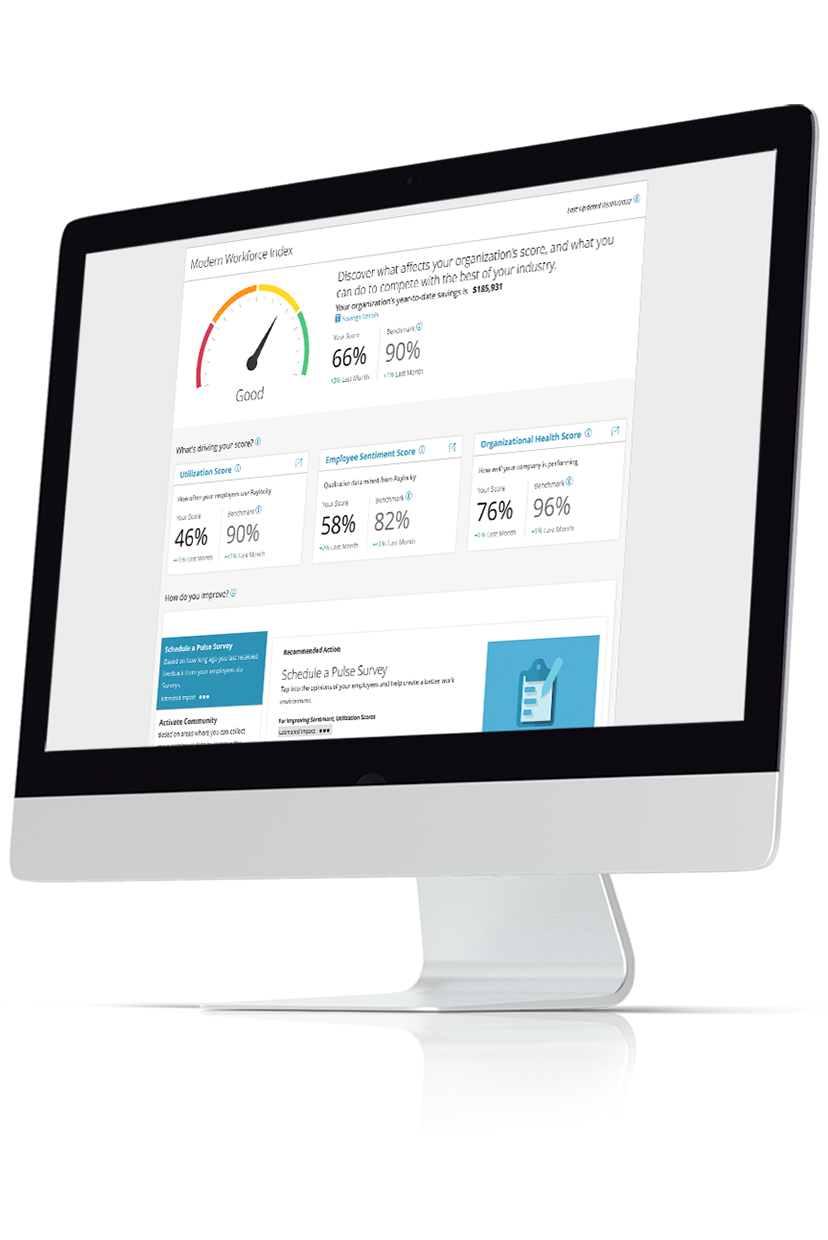resources
What Is Employee Experience (EX)?
March 21, 2023
Positive employee experience ensures you attract and retain top talent, helping you become a leader in your industry. Let us help you solidify your EX strategy.
Blog Post

We talk a lot about the benefits of employee engagement. But what actually gets employees engaged?
Fulfilling experiences.
Every day is made up of hundreds of experiences. Considering we spend a third of our life at work on average, those experiences compound quickly. From finding a good parking spot to getting the promotion you hoped for, each experience impacts how you feel about your job — both day to day and long-term.
Although HR can’t control every experience for every employee, you can be intentional about the experiences you curate and how you facilitate them. An employee experience framework provides meaningful and relevant opportunities for all employees to connect and grow throughout their career with your company.
What is Employee Experience?
Employee experience, sometimes abbreviated EX, is the culmination of every interaction an employee has with your organization from the moment they see your job opening to the moment they leave the company. It’s what they see, touch, hear, smell, and feel as they go about their work.
Employee experience is shaped by three main components:
- Culture: The values of your company demonstrated by how employees are treated and how they treat others. The right culture can energize, motivate, and empower people.
- Technology: The tools employees use to perform their roles. Technology can maximize efficiency and help employees feel confident.
- Workplace: The physical space where your employees work, whether in the office or at home. A good workplace environment improves well-being, boosts concentration, and enhances productivity.
Employee Experience vs. Employee Engagement
Employee experience isn’t exactly the same as employee engagement, but the two are connected. The experience is what you, the employer, create. Engagement is how employees feel about working for your company, which is highly influenced by all of the experiences they have.
The Impact of Employee Experience on Businesses
The effects of positive employee experiences and the resulting engagement are well documented.
A recent meta-analysis by Gallup found that employee engagement levels have a significant impact on business outcomes. Organizations that rank highly for engagement see 14% higher productivity and 23% higher profitability while experiencing 81% less absenteeism and 64% fewer safety incidents.
It should come as no surprise that workers who are satisfied with their jobs are more productive. This is especially evident in customer-facing industries, where quality of service is a key success factor.
An analysis of a large global retail brand estimates as much as a 50% increase in revenue when customer-facing employees are more tenured, higher skilled, and skewed toward full-time work — all measures of employee experience.
Of course, providing a great employee experience will also benefit recruitment and retention, which impact the bottom line as well. A strong employer brand helps you attract top talent. And as long as the experience lives up to the promise, employees will reward your company with loyalty.
5 Stages of the Employee Experience Lifecycle
The employee experience lifecycle has five key stages: recruitment, onboarding, development, retention, and exit.
The experiences at each stage affect employee performance and engagement and build on one another. For example, if your onboarding program gets new employees excited about their future at your company (it should!), then you also need to provide opportunities for employees to grow in the development and retention stages.
Let’s look at these five stages from your employees’ point of view.
1. Recruitment
Even if candidates are familiar with your public brand, the recruitment stage is their first interaction with you as an employer. There are several experiences applicants will have as they begin their relationship with you. What do these candidate experiences convey about your company’s hiring practices and overall culture?
Consider:
- Who are you trying to attract? Do your job postings address their priorities, like compensation or the company’s mission?
- How easy is the application and interview process for candidates?
- Do you often have final candidates who turn down a job offer? If so, what’s missing in the recruitment experience?
Read More: 8 Recruiting Email Templates You Need to Attract Top Talent
2. Onboarding
In this stage, new employees are figuring out how your company works and what their role is. The goal of employee onboarding is to deepen the connection between a new hire and your organization. Generally, new employees are hungry for knowledge — but it’s also easy for them to get overwhelmed.
Consider:
- Do you answer the big questions up front? When and how do employees learn about payroll, schedules, essential equipment, and benefits? Who are their colleagues and when do they meet them?
- What do employees have to know before they start on the job, like safety procedures and compliance policies?
- Do employees have an opportunity to start planning their future with your company?
Hopefully, the entire onboarding stage is infused with your culture so that new employees see your values in action while also learning how their role specifically contributes to the business.
3. Development
Many — but not all — employees want to advance their career. By providing opportunities for them to do that within your organization, they are more likely to stay. Just as important, they can grow the skills that will have the biggest impact on the company’s success.
Consider:
- What are employees’ individual goals for the future? While few would turn down the chance to earn more money, do they want to improve their technical skills, leadership skills, or both?
- Do you offer flexible career paths, training, and tools that will help them achieve those goals?
- How do you foster a culture of learning across the organization?
4. Retention
Improving skills and career advancement are major factors in keeping your best employees engaged. But there are many other employee experiences that make up the retention equation.
Consider:
- Do employees have opportunities to make their voices heard? How do you demonstrate that their opinions count?
- How are employees recognized and rewarded — throughout the year and throughout their career?
- Do you encourage employees to connect with one another through both work-related and non-work-related activities?
Today’s employees are looking for a lot more than a paycheck. They want to work for an organization they believe in and where they experience a sense of belonging.
Read More: Best Employee Retention Strategies & Techniques
5. Exit
Employees leave for all sorts of reasons. They may retire, experience a life change, or decide to pursue other interests. But we can’t ignore the elephant in the room: Employees leave because they are dissatisfied with their employee experience. So, how do you identify and address the root cause of that dissatisfaction?
Consider:
- If you’re losing employees to your competitors, what do they offer that you company doesn’t?
- When do employees leave? For many industries, there’s some churn expected at the entry level, but where do you see other patterns?
- Does your exit process leave employees with a positive impression of your company?
When it comes to evaluating how your organization performs across these five stages of employee experience, the best strategy is to ask employees themselves at each stage. It’s essential to continually check in with employees through surveys and by embracing open dialogue.
Strategies for Creating an Effective Employee Experience
There are many aspects that make up an employee’s overall experience from hire to retire. While some specific events are impossible to control — for example, if a competitor tries to recruit your talent — there are several core strategies at the foundation of a successful employee experience framework.
Ensure Employee Safety and Well-Being
First and foremost, employees want to know that you have their best interests in mind, both physical and mental.
This means a lot more than meeting OSHA requirements. The expectations for work-life balance have never been higher, and employees need to know how your organization supports that balance.
Those supports may be tangible benefits, such as good medical insurance and an employee assistance program, but they also include things like flexible scheduling, training, and providing healthy snacks in the breakroom.
Communicate Clearly and Often
Employees appreciate being kept in the loop, especially when it comes to change. But the days of email newsletters and bulletin boards in the kitchen are long gone.
The key to communicating with employees is reaching them where they are — in the office, on the production floor, on the go, or at home. And with a workforce more tech savvy than ever, modern tools like Paylocity’s social collaboration hub Community help you communicate with employees in the ways they’re most comfortable — which increases engagement.
Put Leadership Front and Center
Today, we hear a lot of words like “authentic,” “genuine,” and “transparent.” Simply put, employees want to hear the truth and they want to hear it from the top. Leaders play a huge part in creating culture, and their involvement in employee experiences big and small shows employees their work matters.
Again, leverage the tech tools available today — a video message from your CEO welcoming new hires is more personal and engaging than a form letter in a PDF.
Foster a Sense of Belonging
Inclusion is more than inviting everyone to the table. It’s making sure everyone has a voice. Deloitte found that promoting belonging can lead to a 56% increase in job performance and a 50% reduction in turnover risk.
While many organizations have made strides to address diversity, equity, inclusion, and accessibility (DEIA) in the workplace, employees are looking for more than stand-alone initiatives. To create a sense of belonging, companies must weave DEIA practices and thinking throughout their culture, values, and business goals.
Make It Personal
Every employee has their own needs and goals. They bring their own interests, personal experiences, beliefs, and preferences. To make employee experiences meaningful for each individual worker, companies should give employees choices.
That means more than letting employees pick between two health plans. Employees want options to learn, grow, and communicate in the ways that best suit them, so that they can take ownership of their career.
Measure — and Change
To ensure the strategies above are truly enhancing the employee experience, you have to evaluate how effective they are.
In addition to directly and regularly surveying employees, there are several other HR metrics that will indicate whether your efforts are working, such as absenteeism and turnover rates. Are employees accessing the benefits you offer, like mental health programs or tuition reimbursement?
When you do survey employees, ask specifically about the strategies you’ve put in place — do they feel well informed, do they trust their leaders, do they have a sense of belonging? Just remember, when employees share their opinions, they want to see them reflected in the company’s actions going forward.
Using Technology to Curate a Positive Employee Experience
The technology employees use each day has a huge impact on the employee experience. Of course, they need the hardware and software to do their jobs, like a laptop, office suite, or inventory management system. But what about all the technology they use every day to communicate, collaborate, and connect at work? These are what truly shape individual experiences, leading to higher engagement and productivity.
An employee experience platform is a lot more than the new water cooler. It offers a place, a reason, and the tools for employees to stay informed, share their ideas, and connect with one another.
For HR, a modern solution reinforces your company’s mission and values, and helps workers design their future. By giving employees more autonomy, HR answers fewer day-to-day questions and can spend more time on the bigger picture.
The advantage of using an all-in-one HR and payroll system like Paylocity is that employees use the same interface for all their work-related tasks — checking their paystub, requesting time off, enrolling for benefits — while they’re also catching up with the latest company news and checking in with co-workers.
Because employee experience tools are integrated throughout the platform, HR can easily track engagement, performance, and sentiment across the employee lifecycle.
See how Paylocity’s software suite connects employees with their colleagues and their company to improve the employee experience. Request a demo today.

Experiences for the Modern Employee
Your employees want communication, collaboration, and connection - to peers, career development, and growth. Empower them with modern, user-friendly tools that stand out from traditional HR functionality. Come together with social tools that encourage seamless collaboration. Move beyond email with video, text, and chat. Enable two-way feedback with surveys. See how Modern Workforce tools get it done today!


